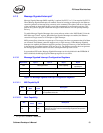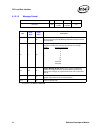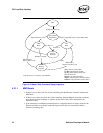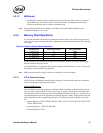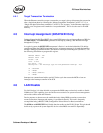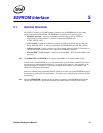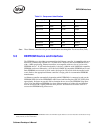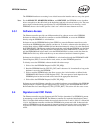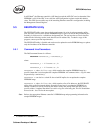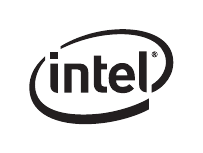
Software Developer’s Manual 91
PCI Local Bus Interface
4.4.1 Target Transaction Termination
When the Ethernet controller accepts a transaction as a target it always disconnects the transaction
after a single data phase by following the “Master Completion Termination” in PCI 2.2, 2.3, or
“Single data phase disconnect termination” in PCI-X. The “memory” in the Ethernet controller is
actually a set of registers and is marked as “non-prefetchable”. This is also the case for FLASH
memory.
4.5 Interrupt Assignment (82547GI/EI Only)
During a Power-On Self-Test (POST), the system BIOS must assign an Interrupt Request (IRQ) for
the 82547GI(EI). The 82547GI(EI) generates an interrupt by sending a hub interface message
through the CSA port.
In a typical system, the 82547GI(EI) component is Device 1 on the bus behind the CSA bridge
component. When the GMCH component receives an interrupt message, it forwards the interrupt
through a PIRQ programmed into the CSA Interface Interrupt Control Register (CSAINTC). Use
the following information to program this register:
Address Offset - 48h
Default Value - 04h
Access - R/W
Size - 8 bits
Bit Field - [2:1]
Description - PCI Interrupt type for CSA generated Interrupt - R/W
00 - Reserved
01 - INT#B
10 - INT#C (default)
11 - INT#D
Interrupts are communicated with a special CSA bus cycle that causes the MCH to issue an
interrupt to the interrupt controller in the ICH.
4.6 LAN Disable
For LAN designs, it is often desirable to program the BIOS setup to selectively enable or disable
LOM devices. This capability gives the end user more control over system resource management
and avoids conflicts with add-in boards.
Device presence or absence must be established early during BIOS execution to ensure that
resource allocation (interrupts and memory) is performed correctly. This task is frequently
accomplished using a BIOS CVDR (Configuration Values Driven on Reset) mechanism.
The 82541xx and 82547GI/EI LAN disable function resides on the FLSH_SO pin. This pin should
be driven by a port on the system Super IO device so that BIOS can control it dependably.



